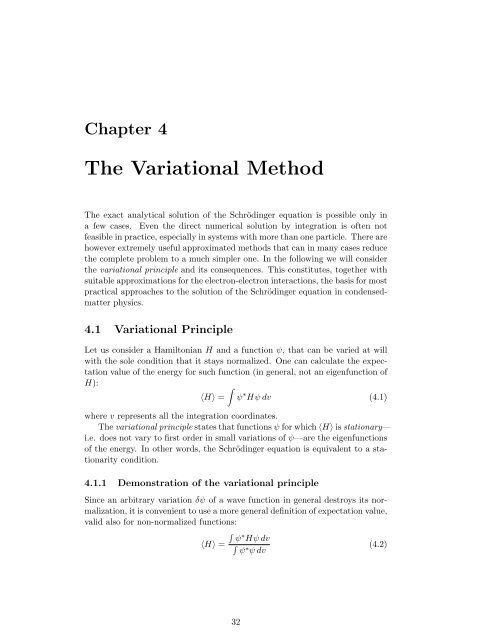Numerical Methods in Quantum Mechanics - Dipartimento di Fisica
Numerical Methods in Quantum Mechanics - Dipartimento di Fisica
Numerical Methods in Quantum Mechanics - Dipartimento di Fisica
You also want an ePaper? Increase the reach of your titles
YUMPU automatically turns print PDFs into web optimized ePapers that Google loves.
Chapter 4<br />
The Variational Method<br />
The exact analytical solution of the Schröd<strong>in</strong>ger equation is possible only <strong>in</strong><br />
a few cases. Even the <strong>di</strong>rect numerical solution by <strong>in</strong>tegration is often not<br />
feasible <strong>in</strong> practice, especially <strong>in</strong> systems with more than one particle. There are<br />
however extremely useful approximated methods that can <strong>in</strong> many cases reduce<br />
the complete problem to a much simpler one. In the follow<strong>in</strong>g we will consider<br />
the variational pr<strong>in</strong>ciple and its consequences. This constitutes, together with<br />
suitable approximations for the electron-electron <strong>in</strong>teractions, the basis for most<br />
practical approaches to the solution of the Schröd<strong>in</strong>ger equation <strong>in</strong> condensedmatter<br />
physics.<br />
4.1 Variational Pr<strong>in</strong>ciple<br />
Let us consider a Hamiltonian H and a function ψ, that can be varied at will<br />
with the sole con<strong>di</strong>tion that it stays normalized. One can calculate the expectation<br />
value of the energy for such function (<strong>in</strong> general, not an eigenfunction of<br />
H):<br />
∫<br />
〈H〉 = ψ ∗ Hψ dv (4.1)<br />
where v represents all the <strong>in</strong>tegration coord<strong>in</strong>ates.<br />
The variational pr<strong>in</strong>ciple states that functions ψ for which 〈H〉 is stationary—<br />
i.e. does not vary to first order <strong>in</strong> small variations of ψ—are the eigenfunctions<br />
of the energy. In other words, the Schröd<strong>in</strong>ger equation is equivalent to a stationarity<br />
con<strong>di</strong>tion.<br />
4.1.1 Demonstration of the variational pr<strong>in</strong>ciple<br />
S<strong>in</strong>ce an arbitrary variation δψ of a wave function <strong>in</strong> general destroys its normalization,<br />
it is convenient to use a more general def<strong>in</strong>ition of expectation value,<br />
valid also for non-normalized functions:<br />
∫ ψ ∗ Hψ dv<br />
〈H〉 = ∫ ψ ∗ (4.2)<br />
ψ dv<br />
32
















